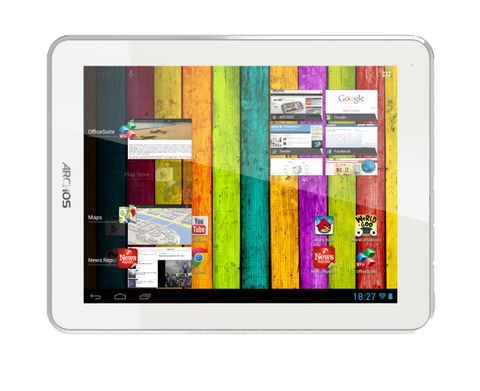IT Pro Verdict
The Archos 80 Titanium gets it right in several key areas, with decent build quality, a reasonable screen and enough performance to enable gaming, browsing and media consumption. Its cut-down specification, poor battery life and awful camera work against it, but it’s a fine option if you need a tablet on a budget.
Pros
- +
Reasonable screen; Good build quality; Smooth application performance
Cons
- -
Threadbare specification; Dreadful battery life; Awful camera
A couple of years ago tablets were luxury items owned by few and desired by many, but an influx of Android devices has seen sales skyrocket and prices plummet. Archos has capitalised on the trend with a roster of cheap Android tablets, but few have been as convincing as the 80 Titanium.
Screen test
As the name suggests, the Titanium is an 8in device that lines up against the 7in Nexus 7 and the 7.9in iPad Mini. It's the equal of the more expensive Apple device in at least one respect, as both share their 768 x 1,024 resolution and 163ppi the Nexus 7 has a slightly higher resolution of 800 x 1,280 and, as a result, a better ppi count of 216.
Whilst the Google tablet has a slightly sharper screen, but it's not too noticeable you'll need to look very close before you spot pixels on the Titanium's panel. The Archos makes up ground with a 4:3 aspect ratio when compared with the skinny Nexus screen it's better for reading books and navigating web pages.

We don't just like the aspect ratio it's overall quality of the panel is good considering the Titanium's price. The measured brightness level of 320cd/m2 is just two candela behind the more expensive Lenovo ThinkPad Tablet 2, and the measured contrast ratio of 1,142:1 is excellent. The combination of good brightness and superb contrast helps this panel deliver punchy, rich images, and the deepest black levels are only a little crushed together. It's matte, too, which we prefer over glossy screens it's easier to use this tablet under bright office lights.
The Archos has a good screen considering the Titanium's price, but it doesn't escape without criticism. It's not bright enough to use comfortably in strong sunlight, and the matte layer adds a tiny bit of grain that isn't present on glossy-screen tablets.
Imitation is flattery?
The design team at Archos hasn't exactly strayed far from the norm when crafting the Titanium's exterior: with its metallic rear and uninterrupted white bezel, this tablet could easily pass for an iPad.
Get a little closer and the differences between the Titanium and its more expensive inspiration become clear. There's no button in the middle of the bottom bezel instead, there's an Archos logo, with the "home" button oddly located at the top-left corner of the device, along with the volume rocker.
The Titanium also has more ports and connectors than the majority of its rivals. The top edge has the main power button, a micro SD card slot that handles up to 64GB of additional storage, mini HDMI and micro USB connectors, a headphone jack and a separate power connector.
Build quality is middling. The bezel between the screen and the body of the device can be flexed a little, and we can see the slim gap between the two components quickly becoming filled with dust and debris. The rear panel depresses slightly when touched. It's bulkier than rivals: the Titanium's 440g weight is a full 100g heavier than the Nexus 7, and its 9.9mm girth sits between the Nexus 7's 10.6mm body and the iPad Mini's 7.2mm frame.
Mike Jennings has worked as a technology journalist for more than a decade and has been fascinated by computers since childhood, when he spent far too long building terrible websites. He loves desktop PCs, components, laptops and anything to do with the latest hardware.
Mike worked as a staff writer at PC Pro magazine in London for seven years, and during that time wrote for a variety of other tech titles, including Custom PC, Micro Mart and Computer Shopper. Since 2013, he’s been a freelance tech writer, and writes regularly for titles like Wired, TechRadar, Stuff, TechSpot, IT Pro, TrustedReviews and TechAdvisor. He still loves tech and covers everything from the latest business hardware and software to high-end gaming gear, and you’ll find him on plenty of sites writing reviews, features and guides on a vast range of topics.
You can email Mike at mike@mike-jennings.net, or find him on Twitter at @mikejjennings


